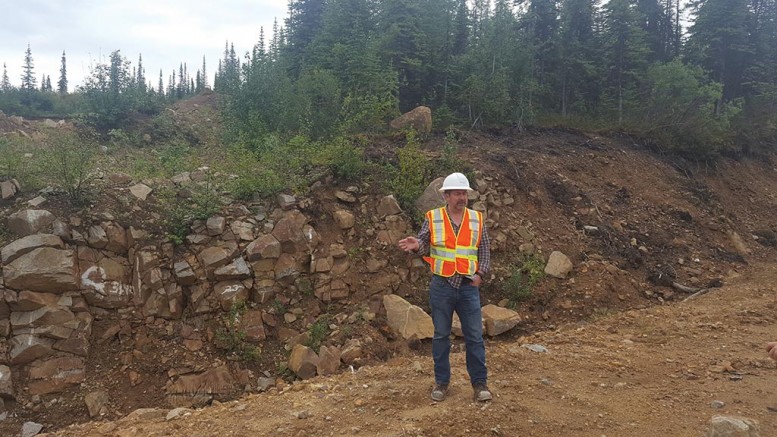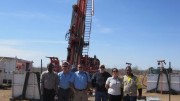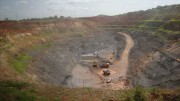KENO CITY, YUKON — There’s optimism at Victoria Gold’s (TSXV: VIT; US-OTC: VITFF) Dublin Gulch camp in the Yukon Territory, after a resurgence in precious metal markets that is creating buzz around development-stage gold projects. Driving northeast into the project site along an all-season, 85 km road after a quick helicopter flight into the village of Mayo, it’s evident that that company enjoys at least one advantage that’s relatively rare for northern mining projects: infrastructure.
A mine here would have ready access to grid power, which runs along the Silver Trail highway, while Victoria’s well-kept, 100-person camp looks ready to shift gears into hosting construction crews.
The company also cut its upfront capital costs by investing in used equipment. In early July, Victoria bought another 110-room, all-season camp for $257,000, and could save up to $6 million in capital expenses by making similar deals.

Atop Victoria Gold’s Eagle gold deposit in the Yukon, looking down towards placer-gold rich Haggert Creek. Photo by Matthew Keevil.
“It’s an example of how relatively weaker markets can help a company at our stage of development,” president and CEO John McConnell said during a conversation at the Eagle camp. “One other benefit is that we can move ahead with a more aggressive schedule when construction begins. Ideally, we’d have everything in place to move ahead next year.”
Victoria has spent the past few years working through the Yukon regulatory process. The company received its quartz-mining licence in late 2013, but had to wait another two years to score its water permit.
After receiving its approvals in December 2015, however, Victoria is hoping markets have improved enough to make final project financing possible.
In April the company locked down a $24-million investment from Electrum Strategic Opportunities Fund and Sun Valley Gold. The cash influx allowed Victoria to follow up on exploration targets and complete an updated feasibility study in mid-September.
“We felt a bit of a difference in the market around April this year,” McConnell continued over coffee in the Eagle dining hall. “Things really picked up after Goldcorp (TSX: G; NYSE: GG) acquired Kaminak Gold and the Coffee project, which draws attention to the jurisdiction, and we’re well positioned with our permits, and have an attractive economic picture.”

Pulling into Victoria Gold’s 100-person camp, 85 km northeast of Mayo, Yukon. Photo by Matthew Keevil.
Victoria’s updated feasibility study includes redesigned open-pit walls and better-developed heap leach metallurgy.
Victoria’s executive vice-president Mark Ayranto says during a driving tour of the Eagle site that the toe of the primary heap-leach pad has been moved up the valley to eliminate the need for a water diversion channel. He also points out the location of a second heap-leach pad east of the main pit.
Upfront capital costs for Eagle are an estimated $370 million, which include a $35-million contingency and all pre-stripping. This is an improvement from capital expense estimates in excess of $400 million under Victoria’s previous economic studies.
The open-pit, heap-leach mine would crank out 200,000 oz. gold annually over a 10-year mine life at all-in sustaining costs of US$638 per oz. The mine plan features an after-tax net present value of $508 million at a 5% discount rate, and a 29.5% internal rate of return.
Victoria has assumed a US$1,250 per oz. gold price and a Canadian dollar exchange rate of US78¢.
“We’ve really brought down the stripping ratio, since a lot of lower-grade ore will be processed as run-of-mine material,” McConnell says during the site tour. “We’ve made other improvements over our previous mine plan. We’ve had three years to optimize during the down markets, and have looked at all the different aspects.”
McConnell says the company is exploring more improvements, including year-round ore stacking similar to Kinross Gold’s (TSX: K; NYSE: KGC) Fort Knox heap-leach operation in chilly Alaska. The company figures the move to stacking ore all year, as opposed to stockpiling, could add up to $64 million in annual net revenue.

Driving around the proposed Eagle mine site at Dublin Gulch. Photo by Matthew Keevil.
The mine plan is based on proven and probable reserves of 123 million tonnes grading 0.67 gram gold per tonne for nearly 2.7 million contained oz. gold. The relatively low grades are offset by a 0.95 to 1 strip ratio, and topographical advantages that are evident when taking in the view atop the Eagle deposit, which overlooks placer-rich Haggart Creek in the valley below.
“In terms of strategy we’re obviously chasing the higher-grade Eagle material, and we’ll mine year-round,” Ayranto adds, as he points out the proposed location of the main heap-leach pad. “We’re planning to stockpile for a three-month period due to cold weather conditions, but we feel that’s a pretty conservative assumption, when you look at Fort Knox.”
Ore would be crushed at a nominal rate of 30,000 tonnes per day through a three-stage circuit. The operation would process 123 million tonnes of ore over the mine life, comprising 108 million tonnes of crushed ore and 15 million tonnes of run-of-mine ore.
Ayranto points out that the secondary pad will have 50 million tonnes in excess stacking capacity for potential mine expansion.
There is still exploration potential across the 550 sq. km Dublin Gulch property, which hosts a 13 km long belt of gold-silver mineralization known as the Potato Hills trend. The company has had recent exploration success at its Olive-Shamrock targets, which add higher-grade material to the new economic study.
Eagle’s mineralization occurs as elemental gold, both as isolated grains and most commonly in association with arsenopyrite, and less commonly with pyrite and chalcopyrite. In descending abundance, the principal sulphides present are pyrrhotite, pyrite, arsenopyrite and chalcopyrite.
Victoria started the year with a $3.6-million budget earmarked for Olive-Shamrock, which involved in-fill drilling and expanding the strike length of confirmed near-surface, high-grade gold.
The Olive-Shamrock zone has been tested over a 1.5 km strike length, with the 2016 program concentrated within an area of 500 by 300 metres.
As a result, Olive now hosts 7 million proven and probable tonnes of 0.95 gram gold for 200,000 contained oz., and 10 million measured and indicated tonnes grading 1.07 grams gold for 329,000 contained oz. gold. Meanwhile, the company released results from Shamrock in late July that are highlighted by 40 metres of 2.09 grams gold from 32 metres deep in hole 16-718c.
“We have Olive and Shamrock, but we need to understand the exploration potential of the entire Potato Hills trend, which may lead to significant discoveries that could extend our mine life,” Ayranto says as Victoria’s trucks pull to a stop near the site of trenching work at Olive. “But I’d point out that Eagle already has strong, robust economics, and we’re fully permitted. That’s especially important with the permit risk out there these days, and that makes Eagle a rare project.”
And the combination of improving gold markets, exploration upside, and near-term production has given Victoria ready access to capital markets so far this year. The company completed another $29-million, bought-deal financing in August, wherein it sold 44.3 million shares at 65¢ each. The financing was led by Raymond James, and included: National Bank Financial, Cormark Securities, Echelon Wealth Partners, Paradigm Capital and BMO Nesbitt Burns.
“The next step for us is project financing,” McConnell says on the ride back to camp. “Obviously that’s contingent on markets and gold prices, but we’ll look at it over the next few months. Ideally we’d have it in place by year-end, but there are a lot of moving parts. We’re cautious about shareholder dilution, so you won’t see us do anything foolhardy in terms of financing.”
Victoria shares have traded in a 52-week range of 12¢ to 80¢, and have more than tripled in 2016 to close at 65¢ close at press time. The company has 496 million shares outstanding for a $288-million market capitalization.
Video Interview with Victoria Gold CEO John McConnell at Dublin Gulch:






Be the first to comment on "Site visit: Victoria on track to gold production at Eagle"